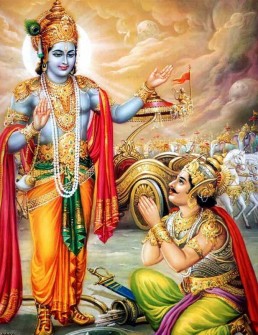Following the word-meaning only, this stanza has been indeed, very often, sadly mis-understood and badly interpreted.
This section in the Geeta is describing single-pointed meditation upon the Highest. Therefore the expression AT THE TIME OF DEATH is to be understood as “AT THE MOMENT OF THE DEATH OF THE EGO.” When all identifications with the body-mind-intellect are consciously withdrawn through the process of meditation, at the HALT-MOMENT of perfect inner silence and tranquillity, “WITH THE MIND UNMOVING,” the meditator can follow the instructions contained in this stanza.
The term “Bhakti” is not to be understood in its cheap connotation, which it has come to gather in its direct translation as ‘devotion.’ Self-less love, seeking a fulfilment in itself, when directed towards the divine with firm faith and an all-out belief, is called Bhakti. Love itself means identifying with the object of love in such a way that the joys and sorrows of the beloved become equally poignant joys and sorrows of the lover. In short, the lovers become one with their beloveds, both in their physical and emotional lives. Therefore, Shankara describes Bhakti as “the identification of the ego with its Real Nature.”
In the context of the stanza here, the important suggestion given to the meditator is that his meditation should be accompanied by a readiness to identify himself intensely with the Principle of Awareness, which has been exhaustively indicated in the previous stanza. He must come to live the Self, within himself, at that still moment of Inward Silence, which rings the death-knell of the deluded-ego.
BY THE POWER OF YOGA (Yoga-balena) — Here we are not talking of some secret and mysterious strength — the Serpent Power — which is the highly guarded secret of a rare few, which should not be spilt to everyone even among those who profess to be the devotees of the Lord. The strength acquired by a meditator, when he meditates upon the Supreme regularly for a long period of time, is the strength — the “POWER OF YOGA” — that is indicated here. This is nothing other than the inward strength, the inward fire, that grows when the mind is withdrawn from its endless agitations and the intellect is peacefully rested in its contemplations upon the infinite qualities of the Absolute.
The meditator, in a relatively short time, discovers in himself a wealth of mental equipoise and an indescribable efficiency, ready to bring his entire mental equipment into the contemplation of the Self in him. When an individual is thus engaged in meditation, all his pranas are concentrated at the point of his meditation — maybe “between the eye-brows,” as it represents the frontal-brain, the seat of steady thought.
Prana is the term used in the Science of Vedanta to indicate “all the different expressions of life’s vitality, through the various instruments and organs of the body.” Life expressing itself as the various functions in a living physical body is called the Prana, which, according to its varied manifestations is classified under five main headings as: Prana: the faculty of sense perception; Apana: the excretory system; Vyana: the digestive system; Samana: the circulatory system; and Udana: the capacity in us to see beyond our present world of knowledge into the field of some greater concept and live it. All these different activities are channels of dissipation through which the vital attention in us is getting exhausted. When an individual gets lost in the Silence within at the moment of his merger with the Self, all these faculties are temporarily arrested. For a seeker walking the Path of Meditation no other violent physical practices at all are needed.
Such an individual — in whom, during the deepest moments of concentration, the mind becomes perfectly silent and tranquil; in whom, through the strength of his steadfast meditation, all manifestations of life’s presence through his physical body become controlled and arrested and when he, in his enthusiasm, totally identifies with the point of his contemplation, the Self — “HE GOES TO THAT SUPREME RESPLENDENT SELF (PURUSHA).”
AS AN INTRODUCTION TO THE MEDITATION UPON OM, THE FOLLOWING IS GIVEN:

